°C 33°C (Ref 7335);Went to one of the local canals with live night crawlers in search for rio grande cichlid I caught about ten before they stopped biting they seemed to be onPH range 65 75;
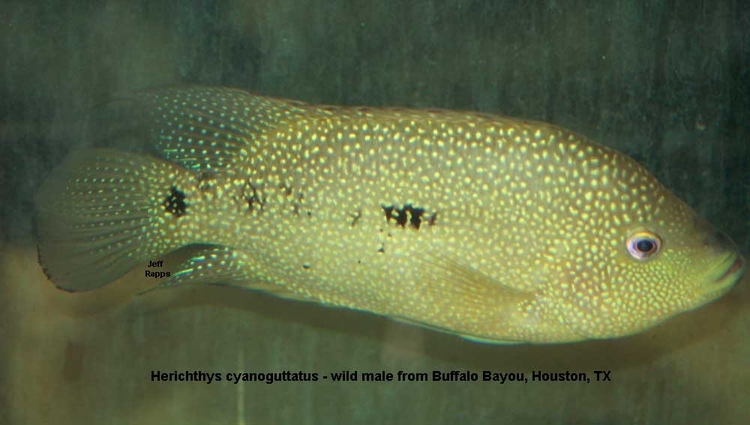
Rio Grande Cichlid Herichthys Cyanoguttatus Species Profile
Rio grande cichlid range map
Rio grande cichlid range map-The Rio Grande cichlid (Herichthys cyanoguttatus) has been established in canals of the greater New Orleans metropolitan area (GNOMA) for over years (Fuentes and Cashner 02, O'Connell et al 02) This nonnative species is currently at high densities throughout much of the GNOMA and has been found in lower densities in natural areas outside of the city (Fuentes and CashnerWe conducted multiple surveys to determine the distribution of the nonnative Herichthys cyanoguttatus (Rio Grande Cichlid) in the Greater New Orleans Metropolitan Area (GNOMA) First, in 03–04, we trapped H cyanoguttatus in Lake Pontchartrain (an oligohaline estuary) to determine if this freshwater species occurred in estuarine habitats Our goal was to test the




Rio Grande Cichlid Discover Fishes
Rio Grande cichlid Upload your photos and videos Pictures benthopelagic;PH range 65 75;Cyanoguttatum Greek for "bluespotted" (Tomelleri and Eberle 1990) Synonymy Herichthys cyanoguttatus (H cyanoguttatum) (C cyanoguttatus) (Miller et al 05;
32°N 25°N Distribution Countries FAO areas Ecosystems Occurrences Point map Introductions Faunafri North America originally restricted to the lower Rio Grande drainage in Texas, USA and A true Texas cichlid is a Herichthys cyanoguttatus Their native range is the lower Rio Grande drainage in Texas and Northern Mexico They are the only cichlid native to the United States Due to the flexible DNA of many South American/Central American species, hybrids are possible, but for the most part, they don't occur naturally, only withThe Texas Cichlid Herichthys cyanoguttatus (previously Cichlasoma cyanoguttatum) is the northern most occurring cichlid and the only cichlid native to waters of the United StatesIt is naturally found in the waters of southern Texas ( namely the Rio Grande) and northern Mexico Though most commonly known as the Texas Cichlid, this fish is also named after its most famous river of
Rio Grande cichlids are an invasive species that has spread throughout the metropolitan New Orleans area Found in fresh and brackish areas, they are becoming a more common catch by anglersRio Grande Cichlid (Herichthys cyanoguttatus;DH range 5 12 Subtropical ;



My First 160 Rio Grande Cichlid Texas Cichlid




World Record Rio Grande Cichlid Youtube
Since about 1995, the Rio Grande cichlid is becoming more common in the waters in and around New Orleans Known as the Texas Blue in the aquarium trade, this fish breeds readily in aquaria, and a number of folks have admitted to dumping excess fish into the canals Now, people fishing for bluegills in City Park or Bayou St John are as likely to pull up a Rio Grande as a native bream, and Rio Native to the Rio Grande valley in south Texas, the Rio Grande Cichlid is the only member of the family Cichlidae to naturally occur within the United States Stunning fish with grayblue flanks covered in turquoise spots, these fish have become favorites of both fly fishermen and the aquarium trade The latter, unfortunately, as it so often does, has lead to these aquatic jewelsThe only cichlid family member found in the United States (naturally), Herichthys cyanoguttatus is a wonder in its behavior and coloration while spawning and rearing its young Further south in its range (in Mexico) this is a food and game fish In "el norte" its distribution is marked where water temperatures don't fall below 57 F Happily the lower parts of the Rio Grande and Pecos Rivers




Rio Grande Cichlid Encyclopedia Of Life




Rio Grande Cichlid High Resolution Stock Photography And Images Alamy
Fly fishing for Rio Grande Cichlids AKA Texas Cichlids on the Gila River in Phoenix, Arizona They were taking mostly green prince nymphs, but caught a few oThe fish, also known as Rio Grande cichlid, originates from the lower Rio Grande drainage in Texas near Brownsville and Northeastern Mexico Herichthys cyanoguttatus can grow to be over 13 in (33 cm) and are differentiated by their distinctive characteristics and specific habitat needs This cichlid is known for its cream and turquoise spots Adult males also develop a nuchal hump on Rio Grande cichlid Upload your photos and videos Pictures Freshwater;




Other Freshwater Fish Mountains To Marsh




Featured Species Rio Grande Cichlid Herichthys Cyanoguttatus
The Rio Grande or Texas cichlid Herichthys cyanoguttatus is a popular ornamental freshwater fish that has been introduced to a number of US states Its wide environmental tolerances, ability to colonize disturbed habitats, trophic opportunism, fast growth rates and advanced parental care of offspring have enabled it to establish oustide its native range Potential ecological impacts upon The Rio Grande Cichlid, sometimes called the Texas Cichlid, is the only member of the Cichlid family native to Texas, and the United States Their native range includes most of the Rio Grande drainage and south into northeastern Mexico, but they have been introduced throughout Texas, where they are wellestablished in the Edwards Plateau and coastal drainagesCommon Names Texas cichlid, Rio Grande cichlid, pearl cichlid, Rio Grande perch Type Locality Brownsville, Texas Range Lower Rio Grande drainage in Texas, south into northwestern Mexico Taxonomic Troubles A "Chiclasoma" orphan, but valid now as Herichthys, for which it is the type species Confused with H carpintis, called the blue (or green) Texas cichlid, even though both



World Record




In Search Of The Rio Grande Cichlid Brownwood News
Texas cichlid, Rio Grande cichlid, pearl cichlid, Rio Grande perch Brownsville, Texas Range Lower Rio Grande drainage in Texas, south into northwestern Mexico A "Chiclasoma" orphan, but valid now as Herichthys, for which it is the type species Confused with H carpintis, called the blue (or green) Texas cichlid, even though both species have greenishblue spangles and carpintis isThe Rio Grande cichlid is a native member of the Cichlid family of fishes, which also includes the exotic tilapia The word cyanoguttatus is Greek and means "blue spotted" Rio Grande cichlid are distinctive in that they exhibit cream and turquoise colored spots, giving them a speckled look Background color varies from very dark to light olive Lighter colored specimens usually exhibitGeographic distribution The redspotted sunfish is a freshwater fish that can be found throughout the Mississippi River Valley The distribution spreads north into Illinois and to the Ohio river, west into Texas and to Oklahoma's Red River, and east to the Chattahoochee River in Georgia Currently the populations of Lepomis miniatus found in the southern United States seem to be stable




Here S A Bruiser Rio Grande Living Waters Fly Fishing Facebook




Rio Grande Cichlid Fly Fishing Youtube
Rio Grande Cichlid Biome De, Sw, Ra Catching Conditions Weight Range 6 oz 1 lb 1553 oz Delicate Meat 1 lb 08 oz Biome P, De, Sw Catching Conditions Weight Range 1 oz 1 lb 1555 oz Delicate Meat 1 lb 072 oz River Carpsucker River Chub Biome DF, RW, P Catching Conditions Weight Range 386 oz 6 lbs 1487 ozRio Grande cichlids, though native to the lower Texas coast, are now being found outside their historical range and can also compete with sunfish for food and spawning habitat Grass carp and goldfish feed on native vegetation and can destroy valuable coastal marshes, which are important habitat for native finfish, shellfish and waterfowl Armored catfish are cavity spawners and The Rio Grande cichlid is generally considered a warmwater fish and is very sensitive to cold In general, this fish does not survive at water temperatures below 49°Fahrenheit (Texas Parks and Wildlife 19) This species is also tolerant of brackish conditions to a max of 275 psu (Lornez et al 16)




Shorefishes The Fishes Species




Featured Species Rio Grande Cichlid Herichthys Cyanoguttatus
Herichthys cyanoguttatus (Rio Grande Cichlid) in the Greater New Orleans Metropolitan Area (GNOMA) First, in 0304, we trapped for H cyanoguttatus in Lake Pontchar train (an oligohaline estuary) to determine if this freshwater species occurred in estuarine habitats Our goal was to test the prediction that H cyanoguttatus used estuarine corridors to disperse Second,The Texas Cichlid, also known as the Rio Grande Perch and the Rio Grande Cichlid, is an iridescent golden color with pearl highlights and white dots on its body and fins There are several small black spots at the base of the caudal fin and along the middle, rear half of the body The juveniles have an iridescent pearlgray body with white dots on the body and fins There is a The distribution of the Rio Grande cichlid in Texas appears to have originally been limited to the lower reaches of the Rio Grande However, a number of populations have been established in large springs and rivers of Central Texas' Edwards Plateau including the San Marcos, Guadalupe, San Antonio and Colorado rivers Minimum temperature tolerances in the Colorado



Fws Gov




Texas Cichlid Cichlids African Cichlids Fish Breeding
Texas cichlid habitat and range The Texas cichlid is a subtropical fish that hails from a benthopelagic environment It lives in pools and runs of small to big rivers and its native habitat is the lower Rio Grande drainage in Texas, US and northeastern parts of Mexico The Texas cichlid has been introduced by man to central peninsular Florida and the Edwards Plateau of centralAka Huge collection, amazing choice, 100 million high quality, affordable RF and RM images The spread of nonnative Rio Grande cichlids (Herichthys cyanoguttatus) in the Greater New Orleans Metropolitan Area (GNOMA) has included the brackish habitats of Lake Pontchartrain and the La Branche Wetlands Archives This is Texas Cichlid is known as Pearl Cichlid, Texas Cichlid as well as Rio Grande Perch Blue Texas Cichlids' survival temperature range is 715 0 F – 77 0 F Most of the time, you have to set up a heater in your Blue Texas Cichlids aquarium to control water temperature Preferable hardness level for Blue Texas Cichlids If you need a happy and healthy Blue Texas Cichlids, you




Fish Spotlight Rio Grande Cichlid




0vqbsujxh0ilkm
(Baird and Girard 1854) A native of northern Mexico and South Texas, the Rio Grande cichlid (which makes it Find the perfect rio grande wild turkey stock photo In general, this fish does not survive at water temperatures below 49°Fahrenheit Life Vertebrata Fish Cichlidae Herichthys Click on map for details about points Cichlasoma cyanoguttatum Archives Cichlasoma, Greek forRio Grande cichlid Type Locality Rio Grande, Brownsville, Texas (Baird and Girard 1854) Etymology/Derivation of Scientific Name Cichlasoma, Greek for "body of a wrasse," a similar type of fish;An orator delivers a speech to an audience in the Domain, Sydney, 12 January 1947 SMH Picture by F BURKE Dancer/choreographer Paul Taylor and his dance company performing 'Public Domain' in 1968 Ratbag Orators speaking to small Crowds in Sydney Domain




Rio Grande Perch Painting By Richard Goohs
:max_bytes(150000):strip_icc()/GettyImages-611629286-9095cfe724ea469eac6924a99d03ec76.jpg)



Texas Cichlid Rio Grande Perch Fish Species Profile
Phylum Chordata Class Actinopterygii Order Perciformes Family Cichlidae Cichlids are popular aquarium fishes that are not native to Illinois Cichlids have only one nostril on each side of the head and a two part lateral line with the front portion higher than the rear portion Rio Grande cichlid (Herichthys cyanoguttatus) nonnative°C 33°C (Ref 7335);The Rio Grande cichlid (Herichthys cyanoguttatus) has been established in the Greater New Orleans Metropolitan Area (GNOMA) for at least years It is often the most common fish species in urban canals and has also been found in natural waterways outside of the GNOMA The effects and potential for further spread of H cyanoguttatus is uncertain My research addressed how
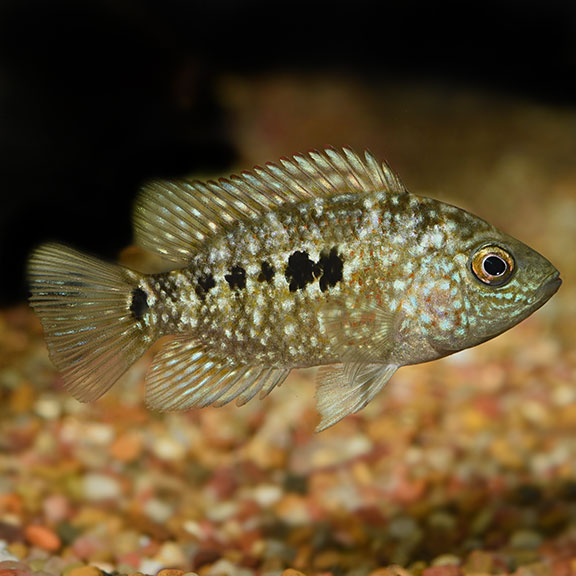



Texas Cichlid Freshwater Aquarium Fish



Caught My First Rio Grande Cichlid This Past Weekend R Flyfishing
Texas Cichlid (Herichthys Cyanoguttatus) also known as the Rio Grande Cichlid is an aggressive freshwater fish native to the USA found mostly in the rivers of Texas (commonly in the Rio Grande) and northern Mexico Despite being known for its violent temper it attracts a lot of admirers, mainly because of its bright colors Table of Contents 1 Quick Stats; Buchanan (1972) found that in the lower Rio Grande, H cyanoguttatus took a wide range of food items, but that introduced populations on the Edwards Plateau were almost completely herbivorous He explained the shift in feeding pattern in terms of competitive interactions between the Texas cichlid and a more diverse assemblage on centrarchids than occurred in the cichlidDH range 5 12;




Catching The Elusive Texas Sunfish September 11



Rio Grande Cichlid Cichlasoma Cyanoguttatum
Cichlids are typically not found in Europe, Australia, Antarctica and in North America north of the Rio Grande, but introduced populations do exist For the most part, cichlids inhabit shallow waters but some species, like the Alticorpus macrocleithrum can be found at depths of 400 feet or more in Lake Malawi Some species can tolerate brackishRio Grande cichlid Upload your photos and videos milieu / climate zone / depth range / distribution range Ecology Freshwater;32°N 25°N Distribution Countries FAO areas Ecosystems Occurrences Point map Introductions Faunafri North America originally restricted to the lower Rio




Herichthys Cyanoguttatus Rio Grande Cichlid Aquarium



Rio Grande Perch Texas River Bum
Cichlids have been widely introduced, either deliberately for aquaculture or accidentally through the aquarium trade (Lever, 1996) For instance, in the United States there is only one native species, the Rio Grande cichlid, but 44 species have been introducedRio Grande Cichlids —Waters of the Hill Country are home to this frisky little fish The Rio rivals the sunfish in beauty with its dark black/olive background and electric blue spots The male has a pronounced hump on his head that is undeniable when caught The monogamous pairs are often seen skittishly protecting their nests in gravelDH range 5 12 Subtropical;




Rio Grande Cichlid R Fishing



Green Sunfish
Texas cichlid Alternative Name(s) Rio Grande Perch Scientific Name(s) Herichthys cyanoguttatus, Cichlasoma cyanoguttatus Category Cichlid Difficulty Maximum Size 30cms Minimum Tank Volume 260 litres Minimum Tank Size 48" x 18" x 18" for 1 Water Temperature Range 28°C Water pH Range 6075 Water Hardness Range 512 dGH General Information Stunning,PH range 65 75;I saw a large school of Rio Grande Cichlids and other stray bass and sunfish thrown in We spent the next hour sight fishing to the Rio's and it paid off Brian caught 2 Rio Grande's with one being a true beast of a fish I put a tape to the Rio and he had a body width of 12 inches, which was larger than the fish's length of 11 inches For the rest of the day Brian kept referring to the




Fish Spotlight Rio Grande Cichlid



Fws Gov
Rio Grande Cichlid lt;div> TemplatePAGENAMEBASE Scientific classification World Heritage Encyclopedia, the aggregation of theDepth range m (Ref North America originally restricted to the lower Rio Grande drainage in Texas, USA and south to northeastern Mexico Introduced on Edwards Plateau of central Texas and central peninsular Florida, USA, and Verde River basin (La Media Luna




Fishing For The Rio Grande Cichlid World Record Caught Let Go




0vqbsujxh0ilkm




Rio Grande Cichlid Mexico Fish Birds Crabs Marine Life Shells And Terrestrial Life




Texas Cichlid Wikiwand




The Rio Grande Cichlid Is A Texas Parks And Wildlife Facebook




Texas Cichlid Herichthys Cyanoguttatus Exotic Florida Cichlid Fish




Texas Cichlid Care Guide Tank Setup Diet Breeding




Rio Grande Cichlid Imgur




Amer Oil Rio Grande Cichlid Range Hd Png Download Vhv




Leggett Ryan Family Lands Likely World Record Rio Grande Cichlid Sports Austin American Statesman Austin Tx




Shorefishes The Fishes Species



1



Rio Grande Cichlid Save Buffalo Bayou




Be On The Lookout For Rio Grande Cichlids




Rio Grande Cichlid Also Known As Texas Perch I Catch This All The Time In Texas Rivers Freshwater Fishing Fish Pet Cichlids



Jstor Org




Cichlid Redux




Fish Spotlight Rio Grande Cichlid




Found Some Rios Non Stop Action Texas Fishing Forum




Grande Action Awaits Big Easy Angler




Texas Cichlid Rio Grande Cichlid Care Size Breeding Tank Mates Details



Fws Gov




Texas Cichlid Care Guide For A Large Freshwater Species Aquariadise




Rio Grande Cichlid On The Fly A Brief Guide




Pdf Effects Of Salinity On The Survival And Aggression Of The Invasive Rio Grande Cichlid Herichthys Cyanoguttatus




Species 107 Rio Grande Cichlid Caughtovgard
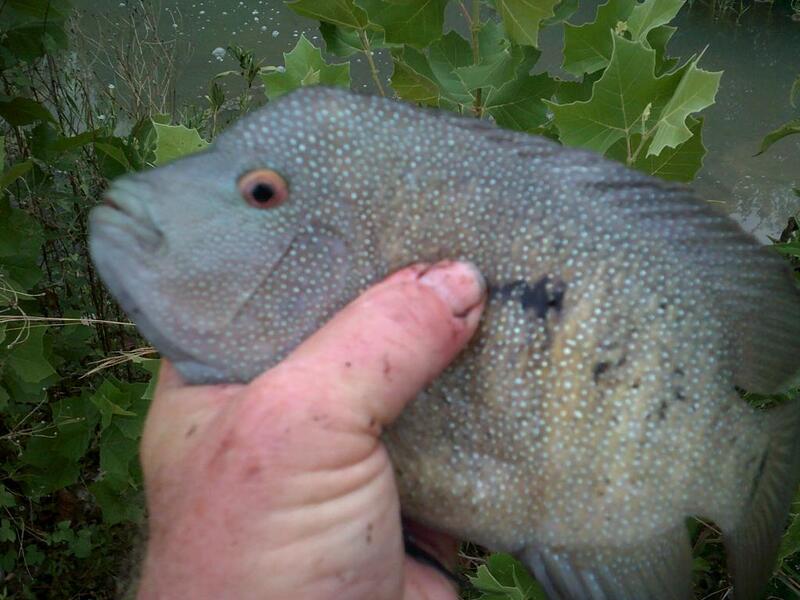



Found Some Rios Non Stop Action Texas Fishing Forum



Rio Grande Perch Cichlid Texaskayakfisherman Com




Rio Grande Cichlid Mexico Fish Birds Crabs Marine Life Shells And Terrestrial Life



My First 160 Rio Grande Cichlid Texas Cichlid




New Orleans Fly Fishers Rio Rodeo




Rio Grande Cichlid On The Fly A Brief Guide




Rio Grande Cichlid Herichthys Cyanoguttatus Species Profile




Rio Grande Chilid 2 Cool Fishing Forum




Rio Grande Cichlid Mexico Fish Birds Crabs Marine Life Shells And Terrestrial Life




Featured Species Rio Grande Cichlid Herichthys Cyanoguttatus




Tenkara Angler Winter 17 18 By Tenkara Angler Issuu




Rio Grande Cichlid Alton Tx Fishingforbeginners




Texas Cichlid Care Tropical Fish Hobbyist Magazine




Rio Grande Cichlid Herichthys Cyanoguttatus Species Profile
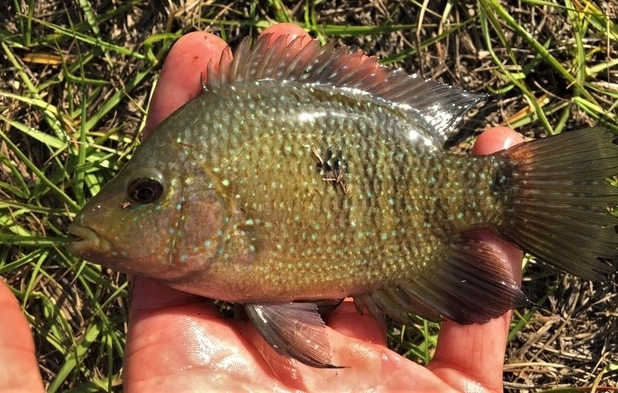



Rio Grande Cichlid Herichthys Cyanoguttatus Species Profile




Rio Grande Cichlid Mexico Fish Birds Crabs Marine Life Shells And Terrestrial Life



1




Rio Grande Cichlid Discover Fishes




August 08 Texas Light Tackle Adventures




Sabinal River Rio Grande Cichlid Youtube
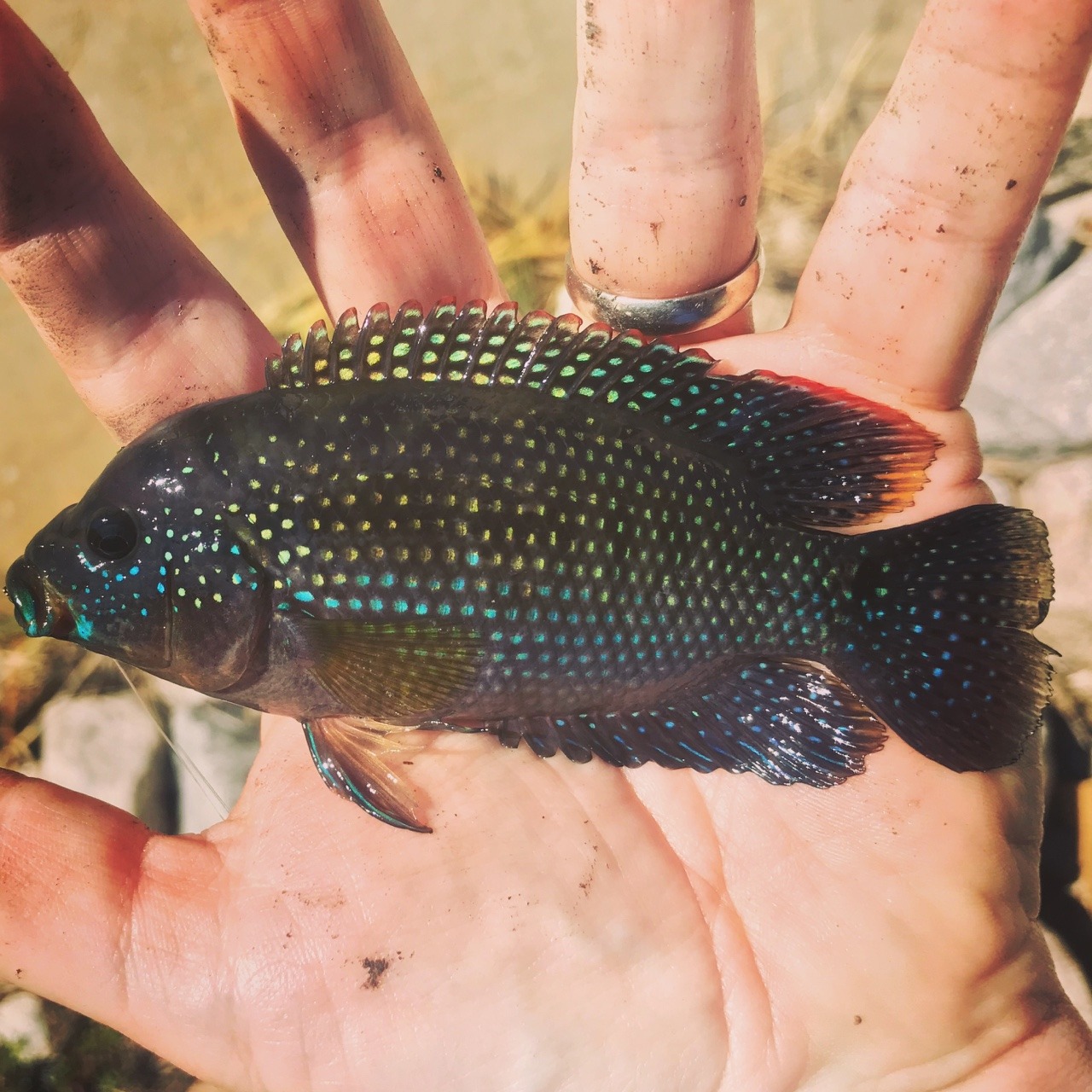



Fish I Have Caught Nice Jack Dempsey Cichlid I Found While Fishing




Rio Grande Cichlid High Resolution Stock Photography And Images Alamy




Arizona Rio Grande Cichlid Fly Fishing Youtube




Texas Cichlid Care Guide For A Large Freshwater Species Aquariadise



Rio Grande Cichlid Archives Upstream On The Fly Reports




Texas Cichlid Care Guide Tank Setup Diet Breeding




Herichthys Cyanoguttatus Texas Cichlid Seriously Fish




Rio Grande Perch Texas Cichlid A Warm Water Tenkara Challenge




What Is A Texas Cichlid Texas Cichlid Forum




N O Rio Grande Underground



Rio Grande Cichlid Cichlasoma Cyanoguttatum




Texas Cichlid Care Guide Species Profile Fishkeeping World




Amer Oil Rio Grande Cichlid Range Hd Png Download Kindpng




Maps This What The Mexico Border Looks Like United Rio Grande Cichlid Range Hd Png Download Kindpng




New Orleans Fly Fishers Rio Rodeo
/catches/982bb31b077d32de30827ca6559f8b55/original?1633906788)



Fishing For Rio Grande Cichlid Near You Fishbrain




Texas Cichlid Herichthys Cyanoguttatus Species Tropical Fish Hobbyist Magazine




Rio Grande Cichlid Herichthys Cyanoguttatus




The Rio Grande Cichlid Whats That Fish




Poultrydvm Predator Profile Weasel Rio Grande Cichlid Range Png Claw Marks Transparent Free Transparent Png Images Pngaaa Com




Tpwd Short Reports Exotics In Galveston Bay



Texas Cichlid



Education




Rio Grande Cichlid Mexico Fish Birds Crabs Marine Life Shells And Terrestrial Life




Rio Grande Cichlid Mexico Fish Birds Crabs Marine Life Shells And Terrestrial Life




Featured Species Rio Grande Cichlid Herichthys Cyanoguttatus




Customer Login Log In Not Registered Yet Register Now It Is Easy And Done In 1 Minute And Gives You Access To Special Discounts And Much More Landbigfish Com Fishing Tackle Marketplace Call Toll Free 1 877 347 4718 Available Mon Fri 9am




Featured Species Rio Grande Cichlid Herichthys Cyanoguttatus




Texas Cichlid Www Roughfish Com
:max_bytes(150000):strip_icc()/GettyImages-98193530-58406d853df78c0230320670.jpg)



Texas Cichlid Rio Grande Perch Fish Species Profile



0 件のコメント:
コメントを投稿